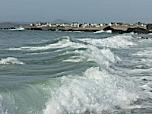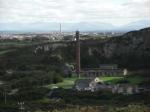LLYNNON MILL
May 30 2010
Day After My Birthday!
It was such a beautiful day at Llynnon Mill with a sheltering blue sky that I knew would present a fabulous backdrop.
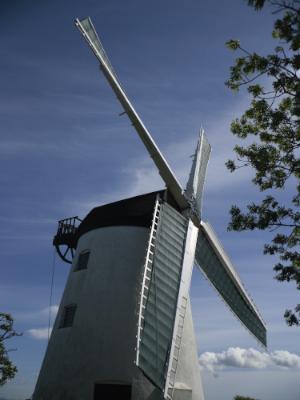
However, even though I’d originally planned a few hours for myself, my aim had been to go to Cemaes Bay to enjoy myself and take a few photos of the inside of St Padrig's (Patrick) Church Cemaes Bay on the headland to the east of this lovely traditional beach village.
Travelling from Valley toward Cemaes Bay I noticed that the Mill was fully set in sail and forever falling inward on itself. Problem, I was in the country and had no cash on me. So, I decided to head for Cemaes and hope to make it back later and in time for the sails to be still set.
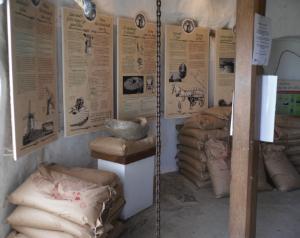
Got the cash and arrived to find that the sail’s had stopped. The miller obviously ready to go home – it was nearly 4:00pm after all. Good news! The sign said 5:00pm.
It has been one of my Anglesey Hidden Gem objectives since last year to take a few photos inside this unique grist mill. In fact the only working mill on Anglesey.
As I paid my £2.50 admission fee, I asked the lovely lady behind the counter if I could also buy a bag of Llynnon Mill ... milled flour to keep behind the counter. At £2 a bag it is bread making pleasure to anticipate.
br>
LLYNNON MILL - WOOD YOU BELIEVE IT
There are a few reasons I wish you to visit the Mill: its beauty and the countryside, to name two.
However, it is the robust workmanship of the wooden machinery that I want you to appreciate and enjoy more than anything else.
For historical information about the Mill may I respectfully guide you to my Main Llynnon Page. There's a link at the bottom of the page.
The woodwork is powerful in its function and yet enticingly tactile and draws you to it.
N.B. Watch where you out your hands and keep an eye on the kids.
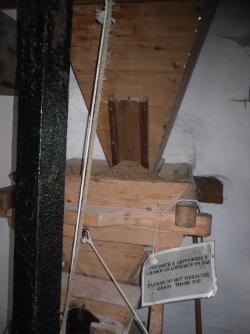
WONDER FOLLOWS WONDER
The photograph above the one above is of the ground floor of the mill, where the milled flour cascades down hoppers and into bags. All bits of machinery lovingly fabricated in the traditional and functional form.
Working with my mind as I do, I am so envious of those who apply their skills by their hands and have tangible and tactile results for their endeavour.
The miller gathers the 100% wheat flour into the sacks and then into the 1.5kg bags for us to purchase and indulge in legitimate adult mud play to create for ourselves that staff of life.
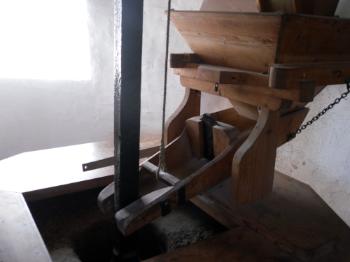
Without the Wind and Gravity and the simple innovative engineering solutions of a bygone age, the beauty of Llynnon Mill would not be known to us.
I know I'm working backwards to the beginning from the bottom but that's the journey for visitors in this working mill.
The miller and his able assistant use the mechanical force contrived by the wind to draw the bags of wheat grain to the top of the mill.
From there it falls to be transformed, as all things do, down into the hoppers and into the heart of the milling stones you'll find once you've climbed up the steps to the first floor.
In a decade or so these shiny wooden surfaces will have worn down to a dull lustre under the hands of thousands of visitors, the Miller and his Capable Assistant.
Be aware that there are three milling stations. This is important for later. I may be asking questions.
I do most sincerely hope that the sails are in full circular flow for you. Watching them sail around and around from below, you can understand why they were part of Don Quixote's psychosis.
It's a bit like standing over a running stream - you get certain compulsions.
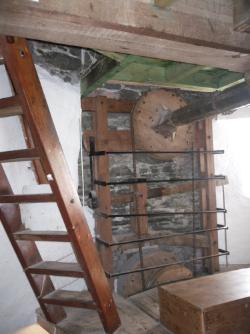
When Llynnon Mill is working I'm afraid that you are not allowed up the last set of steps and into the top floor.
Just look at the large cog below (about a metre across) and the beam above. Human flesh and bone would be rendered cannibalistic lob scouse. No squeals of delight in the workhouse that evening.
The latter is driven mechanically by the rotating sails and its energy is transformed ingeniously from horizontal to vertical and again horizontal at the mentioned cog, which drives everything within the mill.
I must admit having been a naughty boy. After I'd paid my admission the doughty miller and his capable assistant set this quixotic beauty into the wind once again. Thereby, making it very wrong for me to have ventured up those last few steps.
I shall, quite naturally, admonish myself quite severely. If it's the weekend I might hire in some assistance.
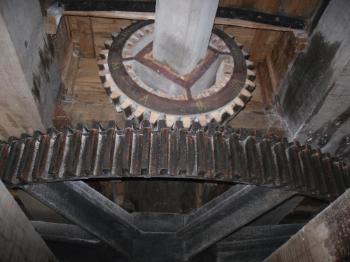
THE MILLER'S TALE
You won't encounter many more companionable and informative people as the Miller and his Capable Assistant. Both love their work and love even more to talk about it.
And why shouldn't they? How could it be possible for them to be anything else but when they view the astonishment and joy of visitors. Especially children, who wish to do nothing other than run around and around and around.
As I mention in my Main Llynnon Mill page (link below) The Llynnon Tea Rooms offer fabulous teas and cakes and you can sit outside on beautiful BIG BLUE SKY afternoons. You can watch in wonder.
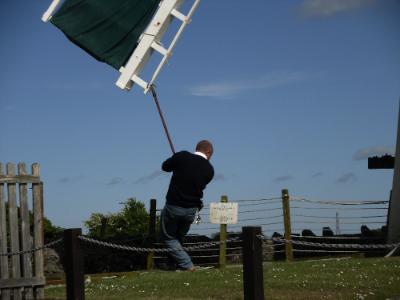
The image above shows you how the Miller (and Capable Assistant) bring Llynnon Mill to a standstill when the day's milling is done.
The Miller slowly applies a break inside the mill and finally catches his ward as a shepherd would catch a wayward lamb with his crook.
Never saw this before and it was utter joy to learn. You can imagine there's a fair bit of effort involved. Once held firmly the Capable Assistant immediately sets to twisting the sail as your mother would the washing and tie it all to one side.
And then the next and the next ...
EMERGENCY BRAKES!!
The wind across the land is not as clean as that on the sea so it can gust to high speeds in such an open area as Llynnon Mill.
This is where the three milling stones come into play, and something I'd never have thought of.
Stick with me for some basic physics.
As the wind turns the sail, energy is lost in turning the main axle. More lost at each cog to cog and at every stage in the mechanical process of milling.
Therefore, no windmill could ever turn at the speed it wished to because the driving forces inside the mill steal its energy to slow it down.
Sometimes, when the wind has risen suddenly and too strong the mill is always in danger of tearing itself asunder and applying the brake is inadequate.
So the Miller and his Capable Assistant set ALL THREE MILLING STONES TO WORK. This is the FINAL OPTION. The loss of energy at this stage is considerable and adequate unto the task of slowing the bleeder down.
Mind you, the Miller (or does he delegate it to his Capable Assistant?) still has to catch the sail and bring it to final halt.
BLINKIN' MARVELLOUS, OR WHAT?
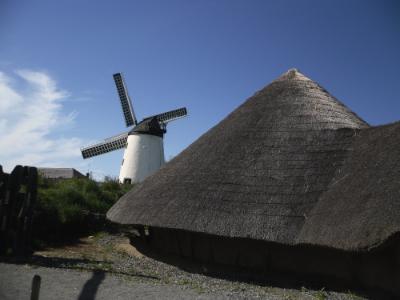
WHAT WOULD IRON AGE MAN MADE OF ALL THIS?
If he's in, why not go and ask him?
Referring once again to gravity, let it guide you down the fine path behind Llynnon Mill to the fabulously re-created Iron Age Settlment.
If it's Spring when you visit, then you can duck to one side as Swallows dive out and back into the highest point (eaves?) to feed their chicks who cheekily stick out their heads.
Click Below to Visit the Iron Age Settlement.
Llynnon Mill Main Page
LLYNNON IRON AGE SETTLEMENT.
Go From Llynnon Mill to WHY ANGLESEY?.
Return to HOME PAGE.

